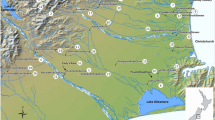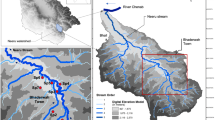Abstract
Water samples from streams and springs in the Great Smoky Mountains National Park were analyzed for fecal coliform, fecal streptococcus, and total coliform bacteria. Levels of bacteria were found to be highly variable but related to elevation, time of year, type of water source, and water level of the streams. Visitors did not seem to be major contributors to bacterial contamination. Levels of fecal coliform and total coliform in most water samples were unsuitable for drinking without treatment. Tennessee state standards for body contact recreation (swimming and wading) were exceeded in a few samples but none from streams suitable for swimming. As a result of these findings, park managers increased efforts to inform visitors of the need to treat drinking water and removed improvements at backcountry springs which tended to give the springs the image of safe, maintained water sources.
Similar content being viewed by others
Literature cited
American Public Health Association. 1971. Standard method for the examination of water and wastewater. American Public Health Assoc., New York, NY.
Anonymous. 1973. Biological analysis of water and wastewater. Application Manual AM 302, Milipore Corp.
Bratton, S. P., M. G. Hickler, and J. H. Graves. 1978. Visitor impact on backcountry campsites in the Great Smoky Mountains.Environ. Manage. 2:431–442.
Bratton, S. P., M. G. Hickler, and J. H. Graves. 1979. Trail erosion patterns in Great Smoky Mountains National Park.Environ. Manage.3:431–445.
Geldreich, E. E. 1970. Applying bacteriological parameters to recreational water quality.J. Am. Water Works Assoc. 62:113–120.
Geldreich, E. E. 1978. Bacterial populations and indicator concepts. Pages 51–98in G. Berg (ed.) Indicators of viruses in water and food. Ann Arbor Sci. Publishers, Inc., Ann Arbor, MI.
Geldreich, E. E., and B. A. Kenner. 1979. Concepts of fecal streptococci in stream pollution.J. Water Pollut. Control Fed. 41:R336-R352.
Hendricks, C. W., and S. M. Morrison. 1967. Multiplication and growth of selected enteric bacteria in clear mountain stream water.Water Res. 1:567–596.
Larson, G. L., and W. E. Hammitt. 1981. Management concerns for swimming, tubing, and wading in the Great Smoky Mountains National Park.Environ. Manage. 5:353–362.
Larson, G. L., R. C. Mathews, Jr., and J. L. Klausmeyer. 1980. A survey of bacterial water quality in Abrams Creek, Great Smoky Mountains National Park.J. Tenn. Acad. Sci. 55:1–6.
McSwain, M. R., and W. T. Swank. 1977. Fluctuations in naturally occurring populations of enteric bacteria in oligogrophic streams of W. North Carolina, USDA Forest Service Res. Paper SE-158. 12 pp.
Mitchell, R., and C. Chamberlain. 1978. Survival of indicator organisms. Pages 15–38in G. Berg,(ed.) Indicators of viruses in water and food. Ann Arbor Sci. Publishers, Inc., Ann Arbor, MI.
Mundt, J. O. 1963. Occurrence of Enterococci on plants in a wild environment.Appli. Microbiol. 11:141–144.
Mundt, J. O., J. H. Goggin, Jr., and L. F. Johnson. 1962. Growth ofStreptococcus faecalis var. liquefaciens on plants.Appl. Microbiol. 10:552–555.
Silsbee, D. G., and G. L. Larson. 1981. Physical, chemical and bacteriological characteristics of streams in Great Smoky Mountains National Park. USDI, National Park Service, Southeast Region, Uplands Field Research Laboratory, Great Smoky Mountains National Park Res./Resour. Manage. Rep. N. 47. 85 pp.
Silsbee, D. G., L. A. Plastas, and H. J. Plastas. 1976. A survey of backcountry water quality in Great Smoky Mountains National Park. USDI, National Park Service, Southeast Region, Uplands Field Research Laboratory, Great Smoky Mountains National Park Res./Resour. Manage. Rep. 10. 66 pp.
Tennessee Water Quality Control Board. 1973. General water quality criteria for the definition and control of pollution in the waters of Tennessee. Nashville, TN.
US Environmental Protection Agency. 1976a. National Interim Primary Drinking Water Regulations.J. Am. Water Works Assoc. 68:57–68.
US Environmental Protection Agency. 1976b. Quality criteria for water. Washington, DC. Pages 79–101.
Author information
Authors and Affiliations
Rights and permissions
About this article
Cite this article
Silsbee, D.G., Larson, G.L. Bacterial water quality: Springs and streams in the Great Smoky Mountains National Park. Environmental Management 6, 353–359 (1982). https://doi.org/10.1007/BF01875067
Issue Date:
DOI: https://doi.org/10.1007/BF01875067




